Costimulation blockade in pig artery patch xenotransplantation - a simple model to monitor the adaptive immune response in nonhuman primates
- PMID: 22909135
- PMCID: PMC3428748
- DOI: 10.1111/j.1399-3089.2012.00711.x
Costimulation blockade in pig artery patch xenotransplantation - a simple model to monitor the adaptive immune response in nonhuman primates
Abstract
Background: CD154 blockade-based immunosuppression successfully prevents both humoral and cellular adaptive immune responses in baboons receiving α1,3-galactosyltransferase gene-knockout (GTKO) pig organs. Using a GTKO pig artery transplantation model in baboons, we evaluated the efficacy of CD28/B7 costimulatory pathway blockade in comparison with CD154 blockade.
Methods: Baboons received artery patch grafts from GTKO pigs, with no (Group1), anti-CD154mAb-based (Group2), or CTLA4-Ig-based (Group3) immunosuppressive therapy. Anti-pig IgM and IgG antibody and cellular responses were monitored. Xenografts were immunohistologically evaluated for antibody and complement deposition, and cellular infiltration.
Results: Group1 baboons developed increased IgM and IgG antibody and cellular responses against GTKO antigens. In Group2, anti-CD154mAb alone prevented the development of both IgM and IgG antibody and cellular responses,but not cellular infiltration of the graft. In the single baboon that received anti-thymocyte globulin (ATG) + mycophenolate mofetil (MMF) + anti-CD154mAb, cellular infiltration of the graft was not seen. In Group3, CTLA4-Ig with ATG + MMF inhibited the cellular proliferative response to pig antigens but did not prevent the IgG response or cellular infiltration.
Conclusions: (i) Artery patch transplantation is a simple model to monitor the adaptive immune response to xenografts; (ii) anti-CD154mAb prevents sensitization but not cellular infiltration (but, without anticoagulation, may result in early thrombosis of a pig xenograft); (iii) although in only one baboon, the addition of ATG and MMF prevents cellular infiltration and (iv) replacement of anti-CD154mAb by CTLA4-Ig (at the doses used), even in combination with ATG and MMF, prevents the cellular proliferative response to GTKO pig antigens but is insufficient to prevent the development of anti-pig antibodies.
© 2012 John Wiley & Sons A/S.
Figures
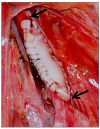



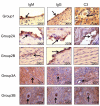

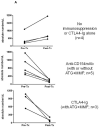

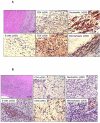


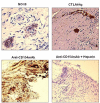
Similar articles
-
Initial in vivo experience of pig artery patch transplantation in baboons using mutant MHC (CIITA-DN) pigs.Transpl Immunol. 2015 Mar;32(2):99-108. doi: 10.1016/j.trim.2015.02.003. Epub 2015 Feb 14. Transpl Immunol. 2015. PMID: 25687023 Free PMC article.
-
B cell phenotypes in baboons with pig artery patch grafts receiving conventional immunosuppressive therapy.Transpl Immunol. 2018 Dec;51:12-20. doi: 10.1016/j.trim.2018.08.005. Epub 2018 Aug 6. Transpl Immunol. 2018. PMID: 30092338 Free PMC article.
-
Increased soluble CD154 (CD40 ligand) levels in xenograft recipients correlate with the development of de novo anti-pig IgG antibodies.Transplantation. 2014 Mar 15;97(5):502-8. doi: 10.1097/TP.0000000000000042. Transplantation. 2014. PMID: 24487395
-
New concepts of immune modulation in xenotransplantation.Transplantation. 2013 Dec 15;96(11):937-45. doi: 10.1097/TP.0b013e31829bbcb2. Transplantation. 2013. PMID: 23851935 Free PMC article. Review.
-
Alpha1,3-galactosyltransferase gene-knockout pigs for xenotransplantation: where do we go from here?Transplantation. 2007 Jul 15;84(1):1-7. doi: 10.1097/01.tp.0000260427.75804.f2. Transplantation. 2007. PMID: 17627227 Review.
Cited by
-
Initial in vivo experience of pig artery patch transplantation in baboons using mutant MHC (CIITA-DN) pigs.Transpl Immunol. 2015 Mar;32(2):99-108. doi: 10.1016/j.trim.2015.02.003. Epub 2015 Feb 14. Transpl Immunol. 2015. PMID: 25687023 Free PMC article.
-
T and B lymphocyte dynamics after genetically-modified pig-to-baboon kidney xenotransplantation with an anti-CD40mAb-based immunosuppressive regimen.Transpl Immunol. 2022 Apr;71:101545. doi: 10.1016/j.trim.2022.101545. Epub 2022 Jan 31. Transpl Immunol. 2022. PMID: 35114360 Free PMC article.
-
Progress in pig-to-non-human primate transplantation models (1998-2013): a comprehensive review of the literature.Xenotransplantation. 2014 Sep-Oct;21(5):397-419. doi: 10.1111/xen.12127. Epub 2014 Sep 1. Xenotransplantation. 2014. PMID: 25176336 Free PMC article. Review.
-
Systemic inflammation in xenograft recipients (SIXR): A new paradigm in pig-to-primate xenotransplantation?Int J Surg. 2015 Nov;23(Pt B):301-305. doi: 10.1016/j.ijsu.2015.07.643. Epub 2015 Jul 21. Int J Surg. 2015. PMID: 26209584 Free PMC article. Review.
-
Further evidence for sustained systemic inflammation in xenograft recipients (SIXR).Xenotransplantation. 2015 Sep-Oct;22(5):399-405. doi: 10.1111/xen.12182. Epub 2015 Aug 21. Xenotransplantation. 2015. PMID: 26292982 Free PMC article.
References
-
- Kuwaki K, Tseng YL, Dor FJ, Shimizu A, Houser SL, Sanderson TM, et al. Heart transplantation in baboons using alpha1,3-galactosyltransferase gene-knockout pigs as donors: initial experience. Nat Med. 2005;11(1):29–31. - PubMed
-
- Tseng YL, Kuwaki K, Dor FJ, Shimizu A, Houser S, Hisashi Y, et al. alpha1,3-Galactosyltransferase gene-knockout pig heart transplantation in baboons with survival approaching 6 months. Transplantation. 2005;80(10):1493–500. - PubMed
-
- Houser SL, Kuwaki K, Knosalla C, Dor FJ, Gollackner B, Cheng J, et al. Thrombotic microangiopathy and graft arteriopathy in pig hearts following transplantation into baboons. Xenotransplantation. 2004;11(5):416–25. - PubMed
Publication types
MeSH terms
Substances
Grants and funding
LinkOut - more resources
Full Text Sources

